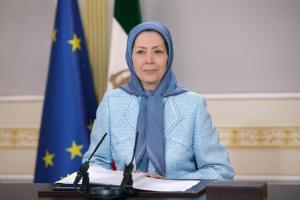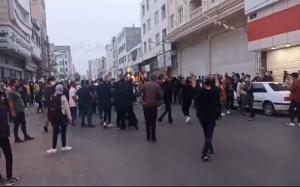Video: 60 Prisoners Killed or Wounded in Evin Prison
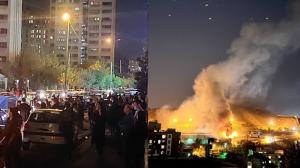
According to eyewitnesses, on the evening of Saturday, October 15, when the prisoners of Ward 7 and 8 in Evin prison were in the open air and began chanting “Death to Khamenei” in support of the uprising, the Special Guard forces stormed the prison.
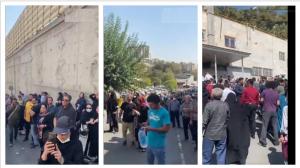
According to eyewitnesses, on the evening of Saturday, October 15, when the prisoners of Ward 7 and 8 in Evin prison were in the open air and began chanting “Death to Khamenei” in support of the uprising, the Special Guard forces stormed the prison.
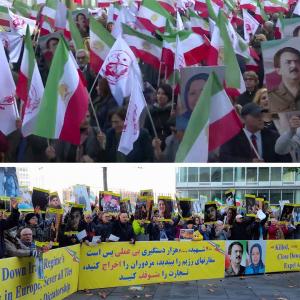
We are fighting to establish a democratically elected republic, a republic based on people’s vote, free elections, and gender equality that defends the autonomy of oppressed ethnic groups within the framework of Iran’s unity and territorial integrity.
Plainclothes & IRGC forces surrounded the prison wards and indiscriminately shot at the windows to prevent the escape of the prisoners who had gone on the roof.
Fifty prisoners were taken from Ward 8, where political prisoners are kept. Fifteen of them were taken to the prison hospital due to the severity of their injuries, and the rest were taken to Gohardasht prison and other unknown locations.
In Ward 7, the prisoners set fire to some of their blankets to counter the tear gas and suffocation caused by it. Simultaneously, the beating of the prisoners stepped up, and clashes between the prisoners of Ward 8 and the guards intensified.
According to an eyewitness, the guards took 11 supporters of the People’s Mojahedin Organization of Iran (PMOI/MEK) out of Ward 8 while the other supporters remained under fire. Some of the prisoners who were hit by bullets and bird shots are Mehdi Vafa’i, Meysam Dehbanzadeh, Hossein Kayhan, Sepehr Imam Jum’e, Reza Qalandari, and Seyyed Javad Seyyedi.
As of Sunday noon, the pellets remained in the torsos and legs of some prisoners, and some of them had been hit by bullets in both legs. They were beaten with sticks, punched, and kicked even after being shot.
According to the other eyewitnesses, Ward 7 caught fire completely, and more than 60 prisoners were killed or wounded by gunshots. Bullet casings were found and seen at the site. According to another report from Ward 4, where ordinary and political prisoners, including PMOI/MEK supporters, are held, the prisoners broke the door and came out during the firing of tear gas and gunfire.
The clashes, chanting, and beating of the prisoners continued until 01:30 am local time. Plainclothes agents and IRGC forces surrounded the prison wards and indiscriminately shot at the windows to prevent the escape of the prisoners who had gone on the roof. At the same time, around Evin, the agents of the regime were targeting houses and windows and wherever the sound of slogans was heard, with live ammunition, pellets, and tear gas.
Mrs. Maryam Rajavi, the President-elect of the National Council of Resistance of Iran (NCRI), called on the United Nations, the High Commissioner for Human Rights, the Human Rights Council, and other human rights organizations to establish an international fact-finding mission to visit Evin as soon as possible with a representative from the Iranian Resistance to assess the crimes against humanity. If the regime claims that no crime has been committed, it should accept the visit by this mission. Mrs. Rajavi expressed her gratitude to the people of Tehran who rushed to the aid of the prisoners in Evin on Saturday night and said that if it were not for this action, this regime would not have spared anything to massacre prisoners, as happened in 1988.
The authorities and the state-run media have been publishing contradictory narratives to cover up this mass crime. In a ridiculous report on Sunday, October 16, the IRGC-affiliated news agency, Fars, wrote, “Some prisoners attempted to escape. They entered the minefield on the northern side of the prison, which is mountainous. It is said that the sounds of the explosions heard were related to this issue”. The same news agency wrote an hour later, “An informed source told Fars, ‘In last night’s Evin prison incident, no prisoner walked on the minefield.’”
Tasnim, another state-run news agency affiliated with IRGC’s Quds Force, also wrote on October 16, “Four prisoners died due to inhaling smoke caused by the fires, and 61 prisoners were also injured. Most of the injured prisoners were treated on an outpatient basis, and only 10 of them are hospitalized, with four reported to be in serious condition.”
At the same time, Akbar Hashemi Rafsanjani’s son Yaser Hashemi’s statement about his brother Mehdi’s release from prison showed that the Evin fire was premeditated. Yasser Hashemi said in a Clubhouse message on October 16: “Mehdi has a day off every two weeks on Wednesdays and returns to prison on Fridays. (This week) they released Mehdi a day or two early, and when he wanted to return on Friday, they told him not to… (in a way) as he said, I thought, God forbid, maybe something had happened to my mother that some tell me to go… Mehdi was in Ward 7, and it seems to me that prison authorities knew that something was going to happen when he wanted to go back on Friday; they told him that there was no need for him to return. Again, it was strange to him why it was like that. Later, he found out that they were informed (that something was going to happen).”
The plight of Teenage Activists in Iran Is Worse Than Reported by Human Rights Groups
On Thursday, Amnesty International issued a report on Iran’s ongoing protests, which indicated that at least 23 minors have been killed in the clerical regime’s crackdown on nationwide dissent. The report noted that this comprises 16 percent of the 144 fatalities the human rights organization has confirmed so far. But Amnesty also acknowledged that a lack of reliable access to information from Iran makes it all but certain that the real death toll, among both adults and children, is significantly higher.
Since the current uprising began roughly one month ago, Iranian authorities have made concerted efforts to limit civilian access to the internet and thus impede both organizing efforts and the dissemination of eyewitness accounts, photographs, and videos of the unrest and associated crackdowns. However, these efforts have been countered by dramatic increases in the use of virtual private networks and other technical workarounds for the government-imposed restrictions. Furthermore, information continues to be collected and shared by the leading pro-democracy opposition group, the People’s Mojahedin Organization of Iran.
The PMOI’s own reports on the present situation indicate that the death toll after one month of continuous unrest is approximately 400, more than twice the figures reported by Amnesty International and other human rights groups. The PMOI’s parent coalition, the National Council of Resistance of Iran, noted that there are “dozens” of juveniles among the deceased. “Their pictures, with their innocent faces, circulate over social media, reflecting the pain the regime has inflicted on Iranians,” the coalition wrote on its website.
The NCRI also indicated that the death toll among minors had already reached double digits on September 30, a date remembered by growing numbers of Iranian citizens and activists as “Bloody Friday.” On that day, agents of the Islamic Revolutionary Guard Corps opened fire on a crowd of protesters in Zahedan, the capital of Sistan and Baluchistan Province, killing as many as 90. Authorities have publicly mischaracterized that incident as clashes between the IRGC and ethnic separatist groups, but videos and eyewitness accounts from the protests confirm that they were part of the same nationwide uprising as has now encompassed more than 170 cities and towns.
The mass shooting on Bloody Friday reflects a comparatively high death toll among the Baluch ethnic minority in other contexts. Amidst a spike in death sentences over the past year, that demographic has accounted for more than 20 percent of all executions despite being no more than five percent of the national population. At the same time, the apparently deliberate killing of juveniles in Zahedan is consistent with the Iranian regime’s status as one of the last countries on Earth to routinely carry out death sentences for persons under the age of 18, in direct defiance of international law.
The comparatively high proportion of deaths among juveniles on Bloody Friday is also indicative of the prominent youth presence in the current protests more generally. This feature has become especially apparent in the first two weeks of October, following the start of the Iranian school year. That milestone saw the expansion of preexisting uprising not only to all 45 major Iranian universities but also to girls’ high schools, where young women have recorded themselves removing their mandatory head coverings, defacing, or denouncing the images of the regime’s Supreme Leader Ali Khamenei that are on display in all classrooms, and even chanting the uprising’s slogans to drive away government officials and militants who had been dispatched to counter their activism.
However, it has been reported more recently that the authorities have taken stronger actions to silence student dissent, such as by dispatching security forces to raid schools. This would be alarming under any circumstances but is made more so by the fact that so many teenagers have already been killed by those same security forces, some of them in raids on private homes.
The NCRI highlighted the case of Nima Shafaghdoust, a 16-year-old boy who was wounded during protests in Urmia but escaped to his home, only to be attacked there by security forces and taken away to an undisclosed location where he died. His disappearance for several days was reminiscent of the cases of two 16-year-old girls whose names and faces have become galvanizing symbols of the regime’s abuses, alongside those of Mahsa Amini, the 22-year-old Kurdish woman whose death at the hands of Tehran’s “morality police” sparked the uprising around the time of her funeral on September 17.
Images of Amini, Nika Shakarami, and Sarina Esmailzadeh all appeared on screen when a state media broadcast was interrupted by activists earlier in October to appeal for even greater participation in the nationwide protests. Shakarami and Esmailzadeh each informed loved ones that they were being chased by security forces before disappearing, and turned up dead days later.
Authorities have claimed that both deaths were caused by either accidental falls or suicide, and they have pressured both girls’ families to corroborate their stories, even in cases where they have already directly attributed the deaths to targeted blows to the girls’ heads, almost certainly delivered by security forces. In the case of Shakarami, authorities even reclaimed control over her body after returning it to the family to bury it secretly in hopes of avoiding public expressions of outrage at her funeral, as had occurred with Mahsa Amini.
Tehran presumably hopes to limit international awareness of such killings, but the international community has appeared more invested in the current uprising than others. Nevertheless, groups like the NCRI have still expressed frustration with a lack of concrete support or public statements affirming the rights of Iranians to revolt against the regime responsible for such abuses. “Anything less,” the coalition wrote, “would only enable the regime to continue with its killing spree of innocent people, and more importantly, children, who are yearning to change their future.”
MESSAGE TO THE RALLY OF FREEDOM-LOVING IRANIANS IN LUXEMBOURG CONCURRENT WITH THE MEETING OF THE EU COUNCIL OF MINISTER
“Iran will be liberated only by the hands and will of its people.”
Fellow compatriots and courageous supporters of the Iranian Resistance,
You, who have gathered here to support your people’s blood-drenched uprising!
You are here to convey the Iranian people’s demand to the European Union ministers, which is overthrowing the entire religious dictatorship. And you want to ask them to stand by the Iranian people in these circumstances.
The stormy uprising of our courageous nation, powerful and determined, has entered its second month.
Our nation has sacrificed 120,000 lives on the path to freedom. The hearts of our people are filled with the pain and suffering of successive generations of Iranian women. And now, they have risen to turn the dark page of our country’s history.
Let us salute the prisoners whose cries of “Death to the dictator” crossed the thick walls of Evin to join the chants of their fellow compatriots all over Iran.
Let us salute the prisoners whose endurance and resistance in the face of the IRGC’s barbaric attack at Evin have given new momentum to the uprising. They showed that Evin remains a bastion of struggle and resistance as it has been for the past fifty-some years.
Let us salute the hundreds of dedicated sons and daughters of Iran who laid down their lives for freedom in this uprising against the mullahs’ tyranny!
Let us salute the courageous mothers who loudly say they are proud of their children’s martyrdom on the path to Iran’s freedom!
Iran has risen up
Once Massoud [Rajavi, the leader of the Iranian Resistance,] said: If Iran rises, the world will rise to support it.
Today look at how the world has risen to praise and admire a rebellious Iran.
For 40 years, Iranian women were flogged and humiliated. Their rights and freedoms were trampled, and tens of thousands of vanguard women from the PMOI/MEK were tortured and executed. Now, they have risen up not only to liberate themselves but also to liberate the whole of Iran.
Now, the students and courageous youths in various cities are shouting, “don’t call it a protest; it is a revolution.”
For years, you and your resistance have promoted, with great suffering, the strategy of Resistance Units to crack the wall of repression and prepare the ground for the uprisings.
The rebellious youth and protesters in 190 cities across Iran are now multiplying their Resistance Units and following up on the PMOI’s strategy.
For years, the misogynist regime had tortured and killed women from the PMOI/MEK and other dissident groups in its dungeons. It executed the brave PMOI girls during the 1988 massacre. In this way, the regime thought it could forever prevent Iranian women from taking their destiny into their own hands.
No compulsory veil, no compulsory religion, no compulsory government
Today, Iranian women have proven their worthy place at the forefront of the uprising and struggle against the regime. They have shown that the goal of their struggle and sacrifice goes far beyond any specific demand. They want to bring down the mullahs’ rule of coercion so that Iranian women and men can achieve all their individual and social freedoms, including the freedom of choosing their attire.
The goal is to bring down the regime of compulsory religion. As the National Council of Resistance of Iran (NCRI) announced 40 years ago, everyone should be free to choose their beliefs and religion based on the principle of separation of religion and state.
And yes, we repeat: No to the compulsory veil, no to the compulsory religion, no to the compulsory regime.
And we are fighting with all our might to establish a democratically elected republic.
We want to establish a republic based on the people’s vote, free elections, and gender equality. This republic defends the autonomy of oppressed ethnic groups within the framework of Iran’s unity and territorial integrity.
Our Baluch, Kurd, and Arab compatriots, in step with our people in the North, South, Center, East, and West, have shown their brilliant solidarity on the ground.
Shahin Gobadi
NCRI
06 61 653 231 ext.
email us here
Intense protests in Tehran | October 16, 2022
Legal Disclaimer:
EIN Presswire provides this news content "as is" without warranty of any kind. We do not accept any responsibility or liability for the accuracy, content, images, videos, licenses, completeness, legality, or reliability of the information contained in this article. If you have any complaints or copyright issues related to this article, kindly contact the author above.

